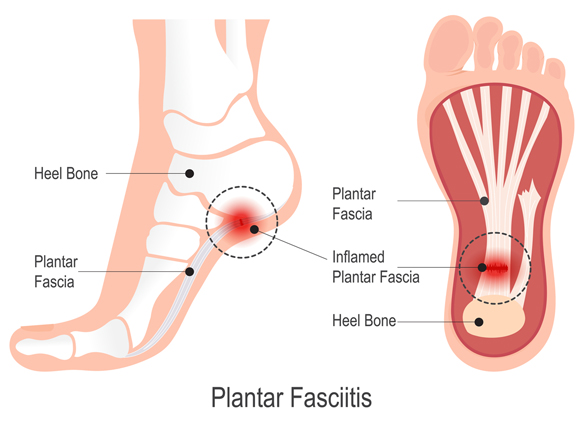Understanding Plantar Fasciitis
One of the most common complaints we see in our office is heel pain, especially pain that’s worst with the first step out of bed or after sitting for a long time. If this sounds familiar, you may be dealing with a condition called plantar fasciitis—a very common cause of heel pain in adults.
Plantar fasciitis is the inflammation of the plantar fascia, the thick band of tissue that runs along the bottom of your foot—from your heel to your toes. This fascia supports your arch and absorbs shock when you walk. Overuse, improper footwear, or biomechanical issues can cause it to become irritated and inflamed.
The result? A sharp, stabbing pain in the heel that’s often worst with your first few steps in the morning, or after long periods of rest.
You’ve probably heard similar terms like tendonitis or bursitis—“itis” simply means inflammation. So, plantar fasciitis literally means inflammation of the tissue on the bottom (plantar) of your foot.

How We Treat Plantar Fasciitis
The good news: about 90% of cases improve with conservative care. Our goal is to reduce inflammation and help the tissue heal. Here’s what a typical treatment plan may include:
-
Ice or Cool Water Soaks
Applying ice or soaking your foot in cool water 2–3 times a day is the most effective way to reduce inflammation and relieve pain. This is one of the most important parts of treatment. -
Anti-Inflammatory Medications
We may prescribe a non-steroidal anti-inflammatory drug (NSAID), or in more severe cases, a short course of oral steroids to quickly reduce inflammation. -
Custom Orthotics
Supportive inserts can offload strain from the plantar fascia. These are not just cushioned pads, but firm, medical-grade orthotics designed to correct biomechanical issues. -
Supportive Footwear
Wearing structured, lace-up athletic shoes—such as those from New Balance, Asics, Brooks, Saucony, or Mizuno—is essential. For dress shoes, we recommend brands like Rockport, Clarks, Ecco, and Naturalizer. -
Cortisone Injections
In some cases, we may inject a mixture of cortisone and local anesthetic directly into the heel. Though it may cause temporary tenderness, this can significantly reduce inflammation and provide long-term relief. -
Physical Therapy
Targeted exercises and treatments can help stretch and strengthen the plantar fascia and surrounding muscles. We often recommend therapy 2–3 times per week for 3–4 weeks.
A Word of Caution
It’s tempting to massage or press on the painful area, but we advise against it. The plantar fascia lies close to the skin, and repeated pressure can actually worsen the inflammation. Gentle stretching is helpful—deep tissue massage is not.
When Conservative Treatment Isn’t Enough
Most cases of plantar fasciitis improve with non-surgical care, but in rare cases where pain persists, advanced treatment options may be needed. These can include shockwave therapy or surgical release of the plantar fascia, depending on the severity of the condition and your individual response to treatment.
The key is early intervention—the sooner you address heel pain, the faster and more effective the recovery. If you’re struggling with persistent discomfort, don’t wait. Contact our office today to schedule a consultation and take the first step toward lasting relief.